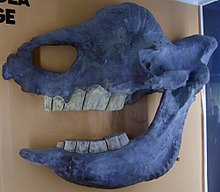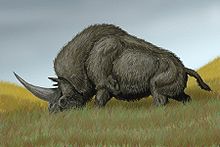Elasmotherium
Elasmotherium is an extinct genus of rhinoceros that occurred in northern Eurasia and belongs to the group Elasmotheriini, a form of rhinoceros with usually only one horn. It first appeared in the Upper Miocene and survived until at least the beginning of the Late Pleistocene. It probably became extinct during the last cold period. Its range included the steppe areas and riverbank landscapes of Eastern Europe as well as Central and Eastern Asia.
Elasmotherium represents one of the largest known representatives of the rhinoceroses. The animals were massively built and adapted to the open regions. A prominent feature is the dome-like bone bulge on the frontal bone of the skull, on which a single horn rested. Due to the lack of fossils, it is unclear how massive this horn was. In addition, the animals had the most reduced number of teeth of all rhinos. The teeth were extremely high-crowned and characterized by conspicuously folded enamel on the chewing surface. Elasmotherium can thus be regarded as extremely specialized in its overall dentition structure, which is especially true for the phylogenetically youngest members of the genus.
Little is known about the way of life. The animals probably lived in open landscapes interspersed with water-rich areas. There they probably fed on marsh plants. Overall, the individual species of Elasmotherium occur rather infrequently in the fossil record compared to other coexisting rhinoceros forms such as the woolly rhinoceros. The genus was first described in 1808 on the basis of a mandible. Its affiliation with the rhinoceroses was not recognized until later. The genus name is composed of the Greek words έλασμα (elasma) for "plate" and θηρίον (thēríon) for "animal", referring to the distinctive structure of the teeth. Five species are recognized today.
Features
Elasmotherium is one of the least studied fossil rhino genera. Overall, they were very robust and large rhinos. The limbs were relatively long in relation to the body. The forelegs ended in three toes each (metacarpus II - IV), as in recent rhinos, with the middle one being the largest. A fourth toe (metacarpus V) was only rudimentarily formed. The hind legs also had three toes each. The rest of the body was relatively strong: the spinous processes at the thoracic vertebrae, where the massive musculature for stabilizing the head was attached, reached lengths of over 50 cm.
The skull was also very massive and large with a robust lower jaw. It had a broad and elongated occiput with a strongly developed bony crest. The occiput, which was clearly elongated in side view and thus angled, caused the animal to hold its head obliquely downwards, similar to what is seen today in the white rhinoceros (Ceratotherium simum). The nasal bone, on the other hand, was slenderly built, making the skull appear distinctly wedge-shaped in plan view. Corresponding to this was an elongated and narrow symphysis on the lower jaw. Furthermore, the nasal septum of the adult animal was completely ossified. This feature does not occur in the rhinoceros species living today and is fossil otherwise known only in the genus Coelodonta, here especially in the woolly rhinoceros (Coelodonta antiquitatis), as well as partially from some representatives of the genus Stephanorhinus. However, since Elasmotherium is not directly related to these two genera, this characteristic must have evolved independently (convergent evolution).
A distinctive feature was a dome-like elevation on the frontal bone, which overhung the skull by about 15 cm and had a diameter of 25 to 35 cm. This elevation represented the base of the horn, inside it consisted of the enlarged frontal sinuses, which communicated with the nasal cavity, possibly serving additionally so as an extension space for the olfactory organs to facilitate the finding of food. Nothing is known about the appearance of the horn, which was made of keratin, due to the lack of soft tissue, but the dimensions of the base of the horn suggest a massive and large horn. The horn location on the forehead clearly distinguishes Elasmotherium from recent one-horned rhinos such as the armored rhinoceros (Rhinoceros unicornis), which carry their horn on the nose.
More recently, it has been possible to demonstrate a sexual dimorphism, at least for the late representatives of Elasmotherium, on the basis of the skull. Thus, cows were generally characterized by a slimmer skull structure, with a less pronounced occipital crest. Furthermore, the dome-like cranial elevation was less prominent.
The dentition of Elasmotherium also showed characteristic features as it was greatly reduced and consisted of only two premolars and three grinders per mandibular arch. Accordingly, the dental formula for the permanent dentition is: 

Skull of Elasmotherium sibiricum in the Museum of Natural History Berlin
Lifestyle
Elasmotherium is one of the largest known mammals of the Pliocene and Pleistocene in Eurasia. Due to its massive body, it is thus likely to have been adapted to productive, nutrient-rich landscapes, such as long-grass steppes or riparian margins. The high-crowned teeth with conspicuously folded enamel indicate highly abrasive food material. Such teeth are often interpreted as an adaptation to grass foods. Since grasses contain fewer nutrients, an animal must eat correspondingly more, which accelerates the abrasion of the teeth. This is further exacerbated by a high silica content, which necessitates the high tooth crowns when the diet is exclusively grass-based. However, the narrow snout of Elasmotherium speaks against a complete specialization on grass food. This was well suited for searching for food plants in damp underground. This view is also supported by the fact that at least the late representatives of Elasmotherium were found in large parts of their range, for example in water-rich southern Siberia, in riparian forests of river banks or on lake shores. This makes it likely that the animals fed on marsh plants whose lower sections were enriched with soil and thus had a high mineral content, which in turn caused the abrasion of the molars. In the case of root-rich food, which may have been torn out of the ground together with the soil, this effect was further intensified. However, some early forms show an abrasion pattern on the teeth that suggest a mixed plant diet of hard and soft components. Overall, the reconstructed low posture of the head points to predominant foraging on the ground. This view is supported by isotopic analyses, which revealed extremely high levels of nitrogen and carbon for Elasmotherium. The levels are outside the variation of other rhinos such as the woolly rhinoceros, and are comparable to those of some local populations of present-day saigas. This may suggest, among other things, an increased consumption of foxtail plants and/or roots. However, contrary to some other postulated opinions, Elasmotherium was not adapted to a semi-aquatic lifestyle. The body proportions in general and the long legs in particular speak against such a way of life. These mostly represent adaptations to open grasslands. Apparently, the animals moved through adjacent or intervening steppe landscapes on their migrations from their feeding grounds in the floodplain or riparian margins. Thus, the habitat of the rhinoceros genus can be assumed to be an open landscape with numerous enclosed aquatic biotopes.
Little is known about the further way of life. The location of the horn on the forehead suggests that it was not, or only to a small extent, used in dominance or territorial fights, in contrast to modern rhinos. Because the (larger) horn is located on the nose in modern rhinos, it can be used much more effectively because more force is transferred to the horn via the neck muscles as the head moves. Therefore, it is assumed that fights between individual representatives of Elasmotherium were highly ritualized. Furthermore, due to its location, the horn probably did not have a function in foraging, as is sometimes the case with modern rhinos. Elasmotherium probably did not have natural enemies due to its size. However, the skull of Atyrau (formerly Gurjew) shows a round skull injury in the forehead area, which, however, had healed during the animal's lifetime. In addition, it is suspected that the animals may have possessed fur due to their relatively northern distribution.

Live reconstruction of Elasmotherium
Questions and Answers
Q: What is Elasmotherium?
A: Elasmotherium is an extinct giant rhinoceros.
Q: When did Elasmotherium live?
A: Elasmotherium lived from 2.6 million years ago (mya) to about 50,000 years ago.
Q: Where have fossils of Elasmotherium been found?
A: Fossils of Elasmotherium have been found in Europe and Asia.
Q: What type of environment did Elasmotherium live and graze in?
A: Elasmotherium lived and grazed on the Eurasian steppes (grasslands).
Q: How big was Elasmotherium?
A: Elasmotherium was a giant rhinoceros, but its exact size is unknown.
Q: Why did Elasmotherium become extinct?
A: The reason for Elasmotherium's extinction is uncertain, but it is believed that environmental changes and hunting by humans may have played a role.
Q: What kind of food did Elasmotherium eat?
A: Elasmotherium is believed to have been a herbivore, grazing on grasses and other vegetation on the Eurasian steppes.
Search within the encyclopedia